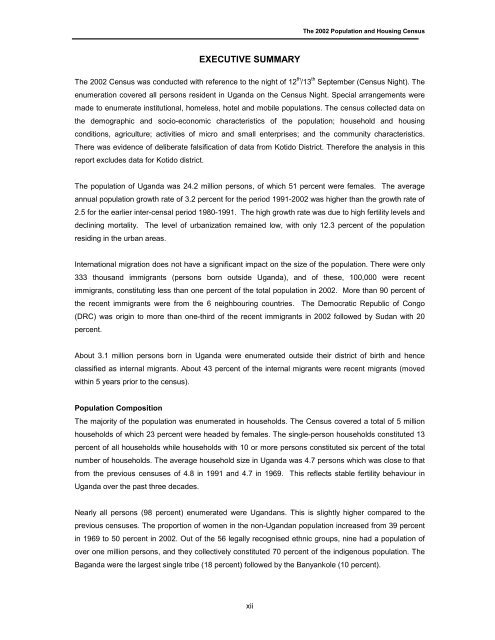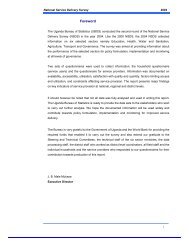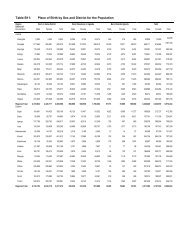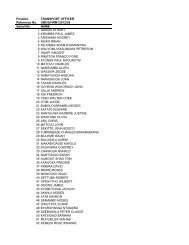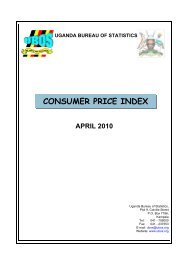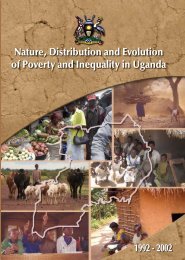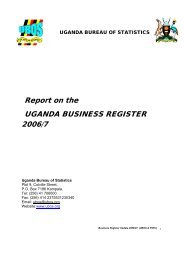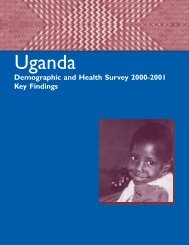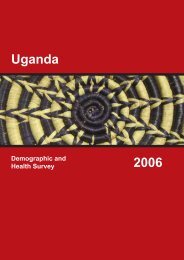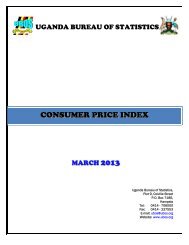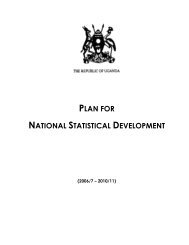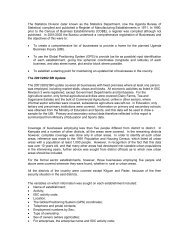Census Analytical Report - Uganda Bureau of Statistics
Census Analytical Report - Uganda Bureau of Statistics
Census Analytical Report - Uganda Bureau of Statistics
You also want an ePaper? Increase the reach of your titles
YUMPU automatically turns print PDFs into web optimized ePapers that Google loves.
The 2002 Population and Housing <strong>Census</strong>EXECUTIVE SUMMARYThe 2002 <strong>Census</strong> was conducted with reference to the night <strong>of</strong> 12 th /13 th September (<strong>Census</strong> Night). Theenumeration covered all persons resident in <strong>Uganda</strong> on the <strong>Census</strong> Night. Special arrangements weremade to enumerate institutional, homeless, hotel and mobile populations. The census collected data onthe demographic and socio-economic characteristics <strong>of</strong> the population; household and housingconditions, agriculture; activities <strong>of</strong> micro and small enterprises; and the community characteristics.There was evidence <strong>of</strong> deliberate falsification <strong>of</strong> data from Kotido District. Therefore the analysis in thisreport excludes data for Kotido district.The population <strong>of</strong> <strong>Uganda</strong> was 24.2 million persons, <strong>of</strong> which 51 percent were females. The averageannual population growth rate <strong>of</strong> 3.2 percent for the period 1991-2002 was higher than the growth rate <strong>of</strong>2.5 for the earlier inter-censal period 1980-1991. The high growth rate was due to high fertility levels anddeclining mortality. The level <strong>of</strong> urbanization remained low, with only 12.3 percent <strong>of</strong> the populationresiding in the urban areas.International migration does not have a significant impact on the size <strong>of</strong> the population. There were only333 thousand immigrants (persons born outside <strong>Uganda</strong>), and <strong>of</strong> these, 100,000 were recentimmigrants, constituting less than one percent <strong>of</strong> the total population in 2002. More than 90 percent <strong>of</strong>the recent immigrants were from the 6 neighbouring countries. The Democratic Republic <strong>of</strong> Congo(DRC) was origin to more than one-third <strong>of</strong> the recent immigrants in 2002 followed by Sudan with 20percent.About 3.1 million persons born in <strong>Uganda</strong> were enumerated outside their district <strong>of</strong> birth and henceclassified as internal migrants. About 43 percent <strong>of</strong> the internal migrants were recent migrants (movedwithin 5 years prior to the census).Population CompositionThe majority <strong>of</strong> the population was enumerated in households. The <strong>Census</strong> covered a total <strong>of</strong> 5 millionhouseholds <strong>of</strong> which 23 percent were headed by females. The single-person households constituted 13percent <strong>of</strong> all households while households with 10 or more persons constituted six percent <strong>of</strong> the totalnumber <strong>of</strong> households. The average household size in <strong>Uganda</strong> was 4.7 persons which was close to thatfrom the previous censuses <strong>of</strong> 4.8 in 1991 and 4.7 in 1969. This reflects stable fertility behaviour in<strong>Uganda</strong> over the past three decades.Nearly all persons (98 percent) enumerated were <strong>Uganda</strong>ns. This is slightly higher compared to theprevious censuses. The proportion <strong>of</strong> women in the non-<strong>Uganda</strong>n population increased from 39 percentin 1969 to 50 percent in 2002. Out <strong>of</strong> the 56 legally recognised ethnic groups, nine had a population <strong>of</strong>over one million persons, and they collectively constituted 70 percent <strong>of</strong> the indigenous population. TheBaganda were the largest single tribe (18 percent) followed by the Banyankole (10 percent).xii


